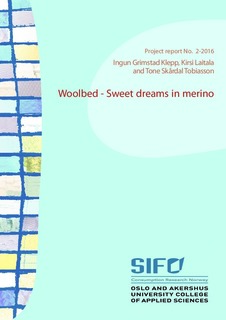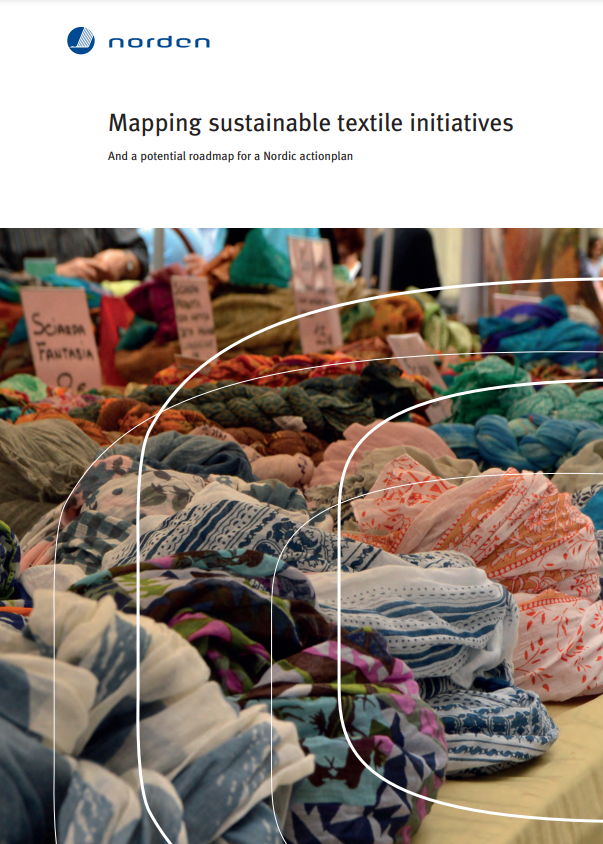Ingun Grimstad Klepp (project leader)
Kirsi Laitala, Michael Schragger, Andreas Follér, Elin Paulander,
Tone Skårdal Tobiasson, Jonas Eder-Hansen, David Palm, Maria
Elander, Tomas Rydberg, David Watson and Nikola Kiørboe.
Summary
This report aims to chart a plan for a coordinated Nordic effort towards sustainable development in textiles and identify ongoing initiatives in the area. The aim was an ambitious plan with a potential for significant reductions in environmental pressures, but also green growth. To reach these goals, we staked out four regions a Nordic plan should include.
- Replace fast fashion
The key to achieving an environmentally significant effect is to
reduce the amount of textiles in circulation. This will reduce the
production of waste and the use of chemicals. - Reduce resource input
The perspective is all about reducing inputs in textiles value chain. This includes various forms of circulatory thinking, material efficiency, as well as commercial forms of recycling and waste management. - Redirect global vs local
Locally produced textiles, with emphasis on ingredients, traditions, uniqueness and innovation, is a new and positive measure that can easily get attention outside environmentally conscious circles. A greater appreciation for good ingredients, and why quality costs, are required to compete with “fast fashion” and shift towards lasting value. Local production has the potential to create green growth and jobs in the region. - Rethink for whom
Nordic countries are at their best an example of inclusive and
democratic societies. The fashion industry however, has marketed itself towards the young and thin. An ethical approach to fashion encompasses not only how clothing is produced, but also who they are produced for and how clothing affects the ability for selfexpression and participation in an open society.
Ongoing initiatives
The mapping showed that there were many ongoing initiatives in the Nordic. The work has mainly focused on the perspective of so-called “reducing resource use”. The more established an initiative is, the more likely it is to be low on innovation. An important dilemma surfaces when attention is on better utilization of waste, as this may indirectly contribute to increased growth in volume.
Knowledge and further research
We lack most knowledge in areas with the greatest opportunity for reduction in environmental impact. The knowledge follows an inverted waste pyramid, where prevention, longevity, etc. are very important, but with a low knowledge-level. Another important distinction is between the market understood as an exchange of money and what goes on outside these formal markets, and there is in general little knowledge about the latter parts of the value chain. The report contains a list of knowledge gaps and suggestions for further research.
Nordic positions of strength
- Consumers have little knowledge about textiles in general and the products do not contain information about basic characteristics (durability, quality, etc.) enabling them to make informed choices.
- The Nordic region’s main strength is an ease of dressing for movement and the outdoor elements.
- Handicraft traditions are strong, however they may be disappearing.
- There is some renewal of interest in more local sourcing.
- Reuse and recycling are the main focus, in spite of lack of a recycling industry and limited market.
- High standing as ethically and environmentally concerned region.
- Tradition of cooperating in spite of language and cultural differences.
- Social networks and electronic tools could be used even more.
- Inclusion, democracy and participation are important values.
- There is a lack of common statistics on the sector.
Policy and regulation
The textile industry is international with few global policy regulations. There is a great opportunity for the Nordic region to make a difference.
Suggestions for a Nordic roadmap
- Avoid symbolic issues and cases, and focus on making a substantial difference environmentally.
- Contribute to a discussion of the relationship between the global and the local in textiles.
- Collectively engage the sector in thinking positive and offensively, being inspiring and visionary.
- The roadmap must work with the whole sector, not just the commercial industry.
- Engage all the Nordic countries and exploit the strength in our differences.
- Ensure knowledge exchange through building on the current state of know-how and the enthusiasm nationally and internationally.
- Acquiring new knowledge where there are obvious blind spots.
- Set specific, ambitious, and achievable (political) goals.
- Support the public debate on central themes.
Click here to read the full report (norden.org).

